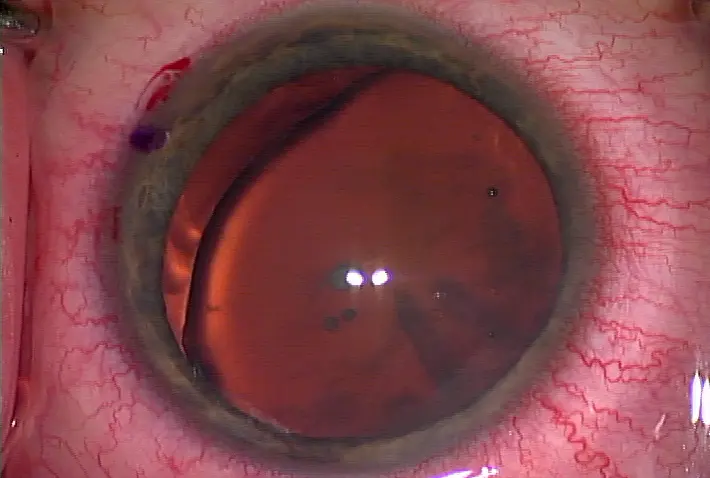Blue light-filtering lens reduces accident risk in simulator
Blue light-filtering lens reduces accident risk in simulator
by Maxine Lipner Senior EyeWorld Contributing Editor
Testing in a driving simulator showed that patients with blue light-filtering lenses had an edge in glare conditions
Source: Robert D. Gray, Ph.D.
AcrySof Natural lens may help ameliorate glare problems while driving
Patients who receive the AcrySof Natural SN60AT (Alcon, Fort Worth, Texas) blue light-filtering lens are not only less susceptible to glare, but also experience fewer collisions with oncoming cars than those with traditional lenses, according to Robert D. Gray, Ph.D., senior lecturer, School of Sport and Exercise Science, University of Birmingham, England. In the January issue of the Journal of Cataract and Refractive Surgery, investigators led by Dr. Gray compared the effects of glare on those who received the blue light-filtering lens to those with a comparable acrylic IOL with no blue light filter.
This study was an outgrowth of an earlier one. “A few years ago in 2007 I did a study looking at the effect of glare on driving in general,” Dr. Gray said. “There has been a lot of anecdotal evidence—almost everyone has had an experience of driving into the sun and headlights where it interferes with driving.” After this study appeared, an Alcon representative contacted Dr. Gray to suggest that perhaps he could use the simulator approach to take a closer look at whether the blue light-filtering lenses would help to reduce the effect of glare on driving.
Dr. Gray saw this request as likely motivated by the recent call for more functional tests of vision for things like intraocular lenses. “We want some tests that are more relevant to real life,” he said. “Driving is something that everyone does, and this is something that may have serious consequence for accidents.”
Comparative study
Included in the study were two groups each with 17 patients who were implanted with intraocular lenses. “The lenses were identical in every way except for the blue light chromophore in one group's lens,” Dr. Gray said.
After the patients were screened and deemed acceptable for the study, they went to the driving simulator. “There was a long phase of allowing them to get used to the driving simulator and get adapted to it,” Dr. Gray said. “One of the main goals there, especially with older drivers, was to prevent any kind of motion sickness.”
The basic experiment involved making left turns in front of oncoming traffic. “The patients drove around an urban environment and came up to signaled intersections and in almost all cases, there was an oncoming vehicle,” Dr. Gray said. “Their task was to try to turn in front of the vehicle if it was safe.” What investigators did was set up the approaching vehicles so that some times it was safe to make the turn. “We forced the person to make a decision,” Dr. Gray said. “We presented conditions where we have a glare source turned on so that it's simulating the sun pointing in their face while they drive, and we alternate that with conditions where there's no glare.”
In the previous study, investigators determined that when the glare source was turned on, people started driving unsafely. “From their turns we could calculate the safety margin that they're willing to accept to make the turn in front of the car,” Dr. Gray said. “The basic effect is that when the glare comes on they accept a smaller and smaller gap, so that they're getting much closer to the oncoming vehicle.”
Greater safety margin
In the study, investigators found that this influenced the number of collisions. “There weren't that many collisions in the simulator, but there were more under glare conditions,” Dr. Gray said. “What we think is happening is that glare through the reduction in contrast is interfering with people's ability to process the motion of the approaching vehicle and judge how much time they have.”
When comparing the blue light-filtering lens to the traditional IOL, investigators found a difference in the patient's decision-making ability while driving. “Patients with the blue chromophore had a reduced effect of glare,” Dr. Gray said. “It still showed some effect but it was much less.”
Investigators found that the safety margin for those with the blue light-filtering lens was significantly greater. For those in the blue light-filtering group there was about a 2.4 second improvement in timing. “In driving, this is quite a big difference,” Dr. Gray said.
Overall, Dr. Gray sees the use of the blue light-filtering lens as a means to help reduce the effects of glare on driving, especially in those who are particularly bothered by glare. “In our first study and also in this study we noticed that there's a very large inter-subject variability in glare susceptibility,” Dr. Gray said. “Some people it doesn't bother at all and others are really incapacitated.” He thinks that those who are susceptible might do better with a blue light-filtering lens. “Especially for those who have trouble with glare, who don't like driving at night or in the sun, this is a possible means to help,” Dr. Gray said.
Editors' note: This study was supported by Alcon, but Dr. Gray has no financial interests related to his comments.
Contact information
Gray: 44(0) 121 414 7239, r.gray.2@bham.ac.uk




留言
張貼留言